
Graham Kays, producer of Tiki Towers, was nice enough to take time out of his busy schedule to talk with WiiWare World about the game. You can check out the full contents of the interview below to find out what he had to say.
WiiWare World: How did you come up with the idea for Tiki Towers?
Graham Kays: Tiki Towers was conceived in the mind of designer Frank Boosman from Republic of Fun before the Wii launched in 2006. Excited by the promise of the new console, he felt that the Wii Remote would work great for games that required a lot of physical interactions. We’ve all played construction-style games as kids, and Frank felt that this would be a great use of the Wii Remote.
While considering the best way to design the building mechanics, Frank heard a talk by Will Wright where Will said something to the effect of “monkeys are funny” and another piece fell into place. From there, he instantly realized that the building pieces could be represented by bamboo and coconuts, and because a good friend was a huge Tiki fan, the tropical/Tiki backdrop seemed the perfect fit for the game.
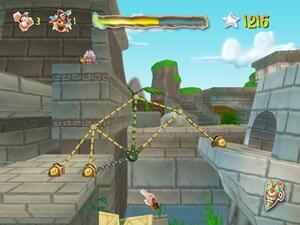
WW: Can you tell us a bit more about the actual gameplay in Tiki Towers?
GK: Tiki Towers is a game of construction, destruction, problem solving, and monkeys. You must reclaim the islands of your tribe by defeating a series of evil enemy chiefs. Your monkey friends help you to build towers in your quest to defeat the enemy chiefs. The enemy chiefs are bent on destroying your towers and driving you from the islands and will cast spells that will disrupt your efforts. As you progress, you must also navigate levels filled with crazy building challenges, and deal with unfriendly wildlife and other environmental obstacles. You have your own repertoire of spells to cast that help you overcome these challenges.
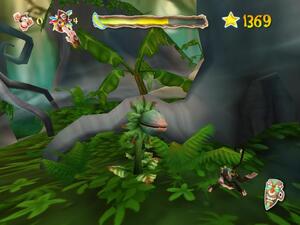
The core of the game is about building. You must build structures to help your monkeys get from the start point to the exit in each level. Bamboo poles of various lengths, connected by coconuts, provide the structure for your towers. Shorter bamboo poles are less likely to break, but don’t provide the speed in building that the more breakable long poles do. Vines can be wrapped around coconut joints for added strength and stability, and are essential for building structures side-to-side.
The game runs in real-time. Time is marching forward as you build your towers and respond to the actions of the Enemy Chiefs.
The asynchronous cooperative multiplayer mode (where one person builds and another person casts spells) allows you to play through the game with a friend or family member.
WW: How long has Tiki Towers been in development?
GK: Tiki Towers took a little over a year of active development to complete.
WW: What control schemes are supported in this game?
GK: The controls for the game are very simple. Using the Wii Remote in the vertical position, all actions are handled by using the pointer and the A Button. In order to build towers, you grasp a connection point with the A Button and drag the pole section to where you want to build. When you’ve positioned it to where you want it, release the A Button and your monkeys will handle the rest. Menu and button actions such as casting spells are also handled with the pointer and A Button.
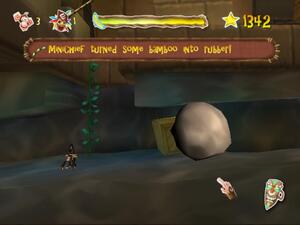
WW: Will there be any online gameplay modes or leaderboards in this game?
GK: We considered these features, but didn’t feel that they added much to the game so we focused our efforts in other areas.
WW: Did you run into any unique challenges while developing Tiki Towers?
GK: Being a physics-based game, getting the physics right was the biggest challenge. After we built the foundation of the physics simulation model, we needed to tweak the parameters so that the towers felt just right. Also, tuning the levels and spells to best utilize and leverage the tower building physics was a big challenge.
WW: What was it like developing a game that makes use of such a unique game controller as the Wii Remote?
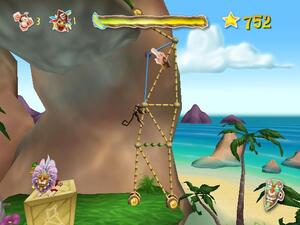
GK: The Wii is great because the Wii Remote is so versatile. You can do so many things with it. We iterated on many different control schemes, but ultimately decided on the simple and elegant use of just the Pointer and A Button. It makes the game so easy to pick up and play that anyone can play and enjoy it.
WW: Are there any differences between the mobile/iPhone versions and the WiiWare version of the game?
GK: Each version has been tailored to its specific platform. In the WiiWare version, you can explore large and expansive levels that have multiple building sections and use the Wii Remote’s pointer functionality to quickly build towers pole-by-pole. Spell casting, monkey management (between casting and building) and the Enemy Chiefs are also exclusively available in the WiiWare version.
Conversely, the mobile and iPhone versions are specifically tailored for play on the go. Accordingly, the levels are shorter and smaller but there are more of them. Because of the closer viewpoint, the personalities and antics of the monkeys are more emphasized, and building is expedited by constructing triangular sections rather than pole-by-pole. Gameplay for mobile is controlled with the directional pad, while the iPhone version has touch screen support.

WW: Many of our readers have been quick to note some similarities between Tiki Towers and the excellent World of Goo. Can you tell us what features differentiate your game?
GK: We’re big fans of World of Goo and think it’s a great game. However, Tiki Towers and World of Goo are fundamentally different experiences and each provide a uniquely fun gaming experience. To begin with, the building experiences are different, and we think Tiki Towers is separated by more dynamic and realistic building mechanics. Players will notice that Tiki Towers has a more sophisticated physics model.
World of Goo uses rigid body dynamics for its physics system, meaning the sections in their towers never break and there is no modeling of tension or compression forces. Your focus is primarily on making sure the towers don’t fall over or sway into environmental hazards. Conversely, Tiki Towers models physics using a mass-spring truss system with linear and angular constraints that models the tension, compression, and shear forces applied to the towers. Simply put, tower sections can become shorter (compress), stretch (tense), sway/sag (shear) and break based on the forces that are applied to them. This makes the towers more dynamic as sections of your tower can break and cause additional force to be applied to other sections of your tower, making it sway and buckle under the weight. In some cases, you can create a chain reaction that will bring your tower crashing down.
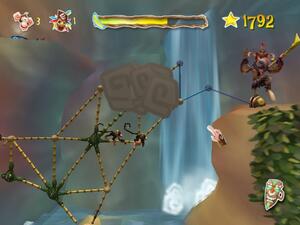
Other aspects of the building mechanics are also different. In Tiki Towers, you build individual segments (whereas in World of Goo, you build with triangles) so the construction of interesting offshoots on your towers and more freedom to build crazy structures is enabled. Plus, the building controls are more natural and overall more simplistic. And your monkeys have an unlimited supply of coconuts and bamboo poles, so you never run out of building materials.
Further, Tiki Towers is not just all about building. The usage of Enemy Chiefs as adversaries adds an additional strategic element to the game. The Enemy Chiefs want to drive you off the islands and will cast spells at your monkeys and towers in order to thwart your progress. Luckily, you have spells of your own to counter the attacks of the Enemy Chiefs, but you need BananaMana in order to cast these spells. You can assign monkeys to chant for BananaMana, but monkeys that are chanting aren’t available for building – so it’s all about balance.
We think Tiki Towers will appeal to a very broad segment of players, as it’s fun and whimsical, yet challenging at the same time. All these features make for a unique playing experience, plus it can all be had for only 500 Wii Points.
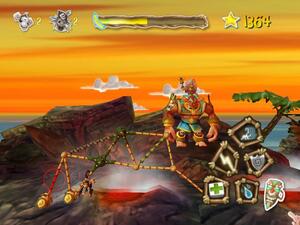
Oh, and don’t forget, Tiki Towers has monkeys. Everybody loves monkeys. Monkeys rule!
WW: It has been announced that Tiki Towers will sell for only 500 Wii Points. What was the thinking behind pricing the game so low?
GK: We believe in Tiki Towers and know people will have an enjoyable experience when playing it. Unfortunately, there are no demos or trials for WiiWare games and we understand that some people don’t want to spend a large amount of money on something they haven’t tried. We wanted as many people to play the game as possible and didn’t want price to be a deterrent so we priced the game accordingly. When you play it, you will likely agree that it provides a lot of fun and gaming value for the price.
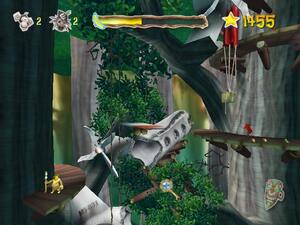
WW: What are some of the advantages/disadvantages of developing for the WiiWare service as opposed to a full retail title?
GK: From a development standpoint, there is little material difference between developing for WiiWare vs. a full retail title. The program file size limitation on WiiWare is the only major issue to deal with as it can reduce both the quantity and quality of your game content compared to what you can accomplish in a full retail title. However, there are business reasons to choose either path. A full retail game requires additional investment in order to create packaging, a printed manual, and manufacture the game disks. Plus, getting a game distributed and out to retailers is not a trivial effort. Making a WiiWare game bypasses all those difficulties, but reaches a much smaller user base. Each path also has different and unique marketing challenges in order to reach customers and let them know about your game and what it has to offer.
WW: Does RealArcade have any other WiiWare projects on the horizon?
GK: We have nothing to announce at this time, but we’ll certainly keep you posted when we do.

Comments 59
"Tiki Towers and World of Goo are fundamentally different experiences and each provide a uniquely fun gaming experience. To begin with, the building experiences are different, and we think Tiki Towers is separated by more dynamic and realistic building mechanics."
So Tiki Towers has better physics than World of Goo?
Bold words Graham, you better back it up.
Unfortunately the graphics and art aren't anywhere near Goo so the game-play has to be great to even have a shot at being Goo-quality.
Well, crap. I'm not sure which of the 2 puzzlers I should get. I'll just get both
For 500 points, I can see myself getting this. Have to be after Christmas probably, because haven't finished gift shopping.
The price really helps in making it easier for me to decide (Especially because of the worry of it being too Simular to Goo.
I hope it's good.
I'll be getting World of Goo before this but this is shaping up to be some good competition! I hope it's as good as they are making it sound.
500 points?
awesome im getting this if the review is good.
Well, the 500 point price and the word "BananaMana" sell me on this game. Congratulations.
Yea, I like that you get to use magic.
@Jogart- Yea, Banana mana is a cool name.
I wonder how long it is or what the replay factor will be.
Could work. It would be nice to have another good 500 Wii Points game.
Hey at the 500 price point one can buy World of Goo and Tiki Towers with the same points card.
True..I was just about to say that..500+1500=2000 what a deal! You can compare and see which one is better most likely WoG
@gameking
i was thinking the same thing
@RADE
ofcourse WoG is the best wiiware game around
hey guys im getting 4000 wii points for Christmas so I was wondering what I should get?
Off either wiiware or VC idc
It was nice to see him go so in depth about the differences between the two games.
gameking23-san, to quote Junpei Iori (Persona 3:FES), "That is a GREAT idea!"
But still, the 500 WP price has me suspicious on the quality of the game, since the price suggests that this game would be cheap in the bad sense of the word...
@shadows262
Well, I'd start out by purchasing the first level of Space Invaders: Get Even to see if you like it and adding on more if you think its worth it. Art Style: ORBIENT is also quite an excellent game if you don't already have it, don't know about the other Art Styles though. Defend Your Castle is great and absolutely worth 500 points. As for VC, Paper Mario and Star Fox 64 are very nostalgic downloads. You've probably purchased Super Mario 64, but that is also excellently nostalgic if you haven't... Whew, there's my two cents.
Still unsure whether Tiki Towers will be shovelware or not, though the interview provided an image of what would appear to be a good game.
Bananamanabananamanabananamanabananamanabananamana...
500 Points! Nice move!
@darkmagi_82
ive got all those games but Space invaders get even and Paper Mario. But hey thanks im thinkin hard bout buying those two.
500 Wii Points?!?!? What a DEAL!
I was expecting at least 1000 Wii Points!
Sweet. Might buy it, but I'm not sold yet.
Also ...... BananaMana
WoG clone or not, this game looks like it is shaping up to be much better than I had predicted.
@shadows262 - Get Super Mario World, Sonic 2 (Genesis), Earthworm Jim, Streets of Rage 2, Super Mario Bros. 3, F-Zero X, F-Zero, Sonic 3, Baseball Stars 2, Ocarina of Time, LoZ: A Link to the Past, LoZ, Kirby's Adventure, Kirby's Dream Course, Bomberman '93 (more fun than BMB if you have friends to play locally, IMO), Gradius, Super Mario Bros., Super Mario Bros. 2, SMB: Lost Levels, Donkey Kong Country 1-3, Super Metroid, Contra III, Mega Man 1-3, Bonk 1-3, or Donkey Kong, Jr.. Did I miss anything? Probably, but I'll add more later.
At 500 points, who can honestly say bad things about it now?
I hope it's good. the interview certainly swayed me that way.
but i won't rely on hype.
At 500 points, who can honestly say bad things about it now?
I can. Tiki Towers killed my parents.
At 500 points, who can honestly say bad things about it now?
Like these two games?
http://www.wiiware-world.com/games/wiiware/hockey_allstar_shootout
http://www.wiiware-world.com/games/wiiware/incredible_maze
Can't fix broken with a low price tag.
Thanks Corbs, nice interview
Now track down the guy from Nintendo who handles VC and strangle him for me
actully, if you get WoG, then you will have 500 points left over in which u can get tiki towers, i recomend goo for anyone who hasnt played, it owns
Sounds good but it also sounds quite complicated too (I like the way he talks about building things freely rather than with triangles, yet all the structures in the screen shots make use of triangles for structural stability) I question whether they're trying to be too clever with this one. The graphics do look like ass (certainly sub N64 quality) but the 500 points price point is definitely a sweetener if the game play holds up.
I'll wait for the review on this one. I've now got World of Goo to keep my obscure building habits happy for a while. That 500 point price does seem a little suspect though... I truly do hope its for the right reasons
Now for my smart arse point: Surely if you're sticking poles in a rounded object like a coconut, which presents very little area for grip on an opposing surface (unless that surface is shaped to hold it in place) they'd keep sliding away under the additional forces being applied by the structure's weight pushing down on them at an angle? Hence, nothing substantial could be built because the foundation beams would keep slipping away making the structure collapse
@shadows262 - I bet it is.. I've got 4000 Wii points also.. what a coincidence. So I'll just take everyone's suggestions also.
This game looks like it can turn out good, but I want to get something that is guarenteed to turn out good. Please no more shovelware!
@clayfrd
ya i got more than half of those gamex but im thinkin bout getting Ocarina of Time now thanx
@RADE
right on!!
hope you have an awesome time w/ your 4000 wii points too
yay more Bridge Builder-like games!
Want a chance to get Tiki Towers for free?
As you've seen by this story, we here at RealArcade are about to release our next WiiWare title. I should have access to gift a few lucky people a free copy of the game directly to their Wii!
Tiki Towers is a family friendly physics based puzzler that features building puzzles and monkeys! Come on - everybody loves monkeys, right?
For more info about the game, check it out here: http://playtikitowers.com/
If you're interested in possibly getting a free copy (We would have to gift it to you via the Wii Friend Code system), please send me your Wii Friend Code via email to: tikitowers@real.com
I will contact the lucky folks who responded back to me in time (I will go by order...first come first served - so hurry!) with our Wii Friend code so they can enable us to make the gift transfer. At this time, I don't know how many free games I'll be able to give out. It could be four - it could be twenty.
I'll send email responses back by Friday and we'll gift the game on Monday. If I get any more details to share, I'll update it here. I can only gift to those Wii users in the US. Sorry! I just discovered that bit.
Also, if selected, you will need to update our friend code on your Wii before Monday and enable your system to receive gifts in order to get the game. Thanks and GOOD LUCK!
@WarioFan63: I'm sorry to hear that. Let's take RealArcade to court!
@AlexSays: Yes, but this game looked pretty good in the first place. TIM and Hockey Allstar Shootout looked disappointing from the off.
^^: planning on running a similar competition for Europe?
I figured Id get vengence by taking up their free offer there.
That's a pretty cool comp thanks RealArcade
I'm going for the gifted game!
Rock and/or Roll! I'm going to be gifted the game
This is going to be my first WiiWare title lol. Hooray for owning a US Wii . Will post impressions once I get it.
I saw this late last night. I hope I sent the email in time. Really cool.
I wonder if I was too late.
I too, seem to have been selected for Free Tiki Towers.
@WarioFan63: Is that the dude from Elite Beat Agents in your avatar? It kinda looks like him but also looks like he's from some old cheesy anime and I can't tell lol.
@chunky--It is indeed from EBA.
@chunky and wariofan-Congrats! But I'll have to kill you if you took my chance away by your winning!
Yes! It is in fact Agent J here. The reason he looks so funny is that is an edit of this one meme.
Theres an old Gamespot Holiday Magizine from Christmas 06 that has a picture of this kid in that same pose going "The greatest thing about the Xbox 360 isnt beating the games. Its showing everyone online that I did." So The Internet thought it was funny and decided to cartoonize the pose. Then they edited it to look like other people were doing it. I happened to find one of Agent J doing it and being a big EBA nut I decided to use it.
I was also happy to see there was one for Kyle Hyde and even The Judge but I dont think theres one for Professor Layton or Travis Touchdown yet.
Actually, I thought I saw this meme referenced in 8-bit is Enough and Im trying to figure out if I was seeing thing.
Okay, chunky and wariofan have nothing to fear, for I as well have been selected to be gifted TikiTowers! Happy day! I will post ASAP with my impressions in the appropiate page. Other companies should take note of this kinda idea!
I'm a lucky one too!
I can't wait to play it. I'll be on this site pretty quick too with my impressions.
Hey, objection blaster. I got it too!
I thought I had missed out because it had been hours before I found out about this and was able to reply. Just found out a few minutes ago.
I was upset because I thought I had missed out, although I had been constantly checking my mail in case they said what the heck and decided to give me one. It's about 7:55pm here and since it had been so long it really surprised me.
@RealArcade- Thanks that was really cool.
@ longtimegamer -- Same here.
I emailed kinda late and just received an email from them a couple minutes ago.
@Alex- Yea, that's awsome glad you made it too. Also I need to remember to check here before I leave from now on, if I don't want to miss anything else like this.
I wonder how many free ones they gave out?
@longtimegamer-By my count (based on who's posted their "Sweet!"s, 5. Thats me, you, Alex, Wariofan, and chunky so far. Kudos to TT staff!
@Alex-You'll probably beat me with your impressions as I have to get my wisdom teeth pulled tomorrow morning. Post in my place until I am able to do so! Make us proud, buddy!
edit: fixed typo
Congrates to you too Objectionblaster, wariofan, and Chunky_Droid!
Make that 6. I got a friend of mine in on this too.
@wariofan- He on here? Everyone that wins has to post on WWW!!
@Objection_Blaster: CLUNKY!? Looking forward to posting all our impressions guys and congrats!
Oh nope sorry.
@WarioFan63: Just looked it up on Encyclopaedia Disturbia. Good stuff! Damn Ecksbauks Kid!
YAY I AM ACCEPTED FOR FREE OFFER!!!!!
And congrats to everyone who was accepted for the offer!!!
This is a great way for TT to start their sales, giving free stuff out .
I hope I'm able to get it for free. =)
First impressions: Tiki Towers is good! Similar to and yet different enough from WOG, it's worth the mesely 500 points.
I will have to give Tiki Towers another try tomorrow. So far, I am not really liking it. I love the 500 point pricing but it is just not as easy to get into as World of Goo. I am also very disappointed in the two player mode.
@WarioFan63: Likin' the EBA avatar. I noticed it a while back. Elite Beat Agents is arguably one of the best games on the DS, alongside Mario Kart, Puzzle League (yes, Puzzle League) and Zelda. Now they need to make a sequel with a bigger and better track list...
Oh, and does anyone else find the Elite Beat Divas to be a turn on?
Regarding free copies of the game: We had a limited number of free copies that were given out earlier this week. Thanks to those who sent inquires showing their interest. If you received an email stating you were among the chosen few and still haven’t been gifted your game, let us know at tikitowers@real.com. We will continue to gift to the remaining games throughout the week.
Thanks again and Happy Holidays!
Show Comments
Leave A Comment
Hold on there, you need to login to post a comment...